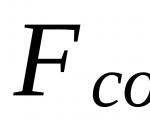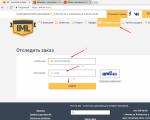Merchandising rules. Golden shelf Golden shelf merchandising
Merchandising– a set of measures aimed at stimulating retail sales by attracting the attention of end customers to brands and groups of Products through the most advantageous placement of goods and P.O.S. Materials in sales areas and store counters.
Merchandising goals:
- Ensuring availability of products for the target audience;
- Highlighting products within a given product group to attract the maximum;
- Ensuring the best perception of each type of product by the consumer;
- Maximum use of the client’s retail space for product placement;
- Rotation according to expiration dates.
Merchandising Tools:
- Display of products in retail outlets according to company standards;
- Posting a P.O.S. — materials;
- Placement of additional commercial equipment;
- The price tag corresponds to the product.
Our goals:
- Place our products first in the direction of travel as a block in each category
- Occupy the golden shelves
- The shelf share of our products must be no less than that of competitors
- Make a display in accordance with company rules
- Each SKU must be represented by at least one face.
Terms and concepts:
- Golden Shelf – a shelf at the buyer’s eye level (at a height of 1.2 m to 1.7 m)
- P.O.S. materials are a means of attracting the attention of buyers to products at the point of sale of products. They use information signs, accessories and accessories with branded symbols, posters, city formats, billboards, etc.
- Facing is a unit of product laid out frontally on a shelf, with the front side facing the buyer.
- SKU – one product name with its characteristics in the manufacturer’s assortment list (for example, art. 001 – “Provencal” mayonnaise in a plastic jar 850 ml.)
Types of purchases:
- Planned purchase – a purchase that is made purposefully, the buyer prepares for it in advance
- An impulse purchase is an unplanned purchase that is made spontaneously without prior preparation.
- Semi-impulsive purchase is a purchase in which the buyer knows what type of product he needs, but gives preference to one or another brand directly at the point of choice.
Rule of the first 6 steps
In the area of the first 6-8 steps, consumer activity in the store is minimal, because... the buyer needs to get used to the store environment and look around.
Features of guiding consumers when choosing a product in a self-service store:
Golden triangle rule»
The greatest purchasing activity on the trading floor is observed inside the so-called “golden triangle”. This is a space limited by three points: the entrance, the cash register and the department for planned purchases.
Conclusion: The main display of products should be located inside the “golden triangle”.
Features of guiding consumers when choosing a product in a store:
The rule for distributing buyer attention:
When moving along the racks, the buyer pays 70% of his attention to the racks to his right and 30% to the racks to his left as he moves.
Conclusion: Try to conquer the racks on the right as customers move!
Features of consumer behavior when choosing a product in a store:
The golden shelf rule»
The buyer pays maximum attention to products located at eye and chest level. When moving products from adjacent shelves to the “gold” shelf, sales increase by 15%.
Quick Search Rule
When entering a department, the buyer expects to immediately find the product he needs and often buys products from the manufacturer who is first in line in this category.
Top shelf rule (shopping comfort)
It is convenient for the buyer to raise his eyes at an angle of no more than 40 degrees.
Merchandising rules:
FOR THE LEAD OF SALES – MORE SPACE ON THE SHELF
The position of the product on the shelf should reflect the position of the product on the market (more sold = more shelf space taken up)
Conclusion: if it is possible to increase the number of facings on the shelf, increase the facings of the most popular product!
Rule for the optimal number of faces:
As the number of facings of one product increases, its sales increase in the following proportion:
1 facing – 100%
2 faces – 123%
3 faces – 144%
4 facings – 161%, etc.
Note: the optimal number of facings for one product is from 2 to 4. A further increase in the number of facings does not significantly affect sales.
Horizontal facings
When horizontal facing is placed vertically, product sales are reduced by 30%!!!
First come, first sold rule:
A product that has a shorter shelf life should always be closer to the buyer than a product with a longer shelf life. When laying out a new batch of goods, it is necessary to check the expiration dates of the products remaining on the shelves. Products with a shorter lead time are at the forefront! (rotation rule).
New items to top sellers:
When a new product is introduced, it should be placed next to the top seller to attract additional attention to it.
Occupying free space
If there is no product indicated in the planogram, fill the vacated space with the best seller, changing the display so that all of the above rules are met.
Can to can, doy pack to doy pack!
Arrangement of products in the corners of the racks
The corners of the rack (“dead zone”) are reinforced with 2-4 facings.
P.O.S.M. Functional purpose
Informing is confirmation of the presence of a product at a given outlet. Provides them with information about the product - price, quality, package size and reasons why they should buy more of the product.
Communication - information about the features of the product.
Orientation - helping the buyer to find a product among others at the point of sale.
Zoning is the division of retail space into zones.
Motivation - encouraging customers to make a purchase.
Exhibition - attracting additional attention to the product by highlighting the place where it is displayed.
Acts as a “silent salesman” at the point of sale.
P.O.S.M. placement areas
Merchandising- a set of measures aimed at stimulating retail sales by attracting the attention of end customers to brands and groups of Products through the most advantageous placement of goods and P.O.S. Materials in sales areas and store counters.
Goals merchandising:
1. Ensuring the availability of products for the target audience;
2. Highlighting products within a given product group to attract maximum consumer attention;
3. Ensuring the best perception of each type of product by the consumer;
4. Maximum use of the client’s retail space for product placement;
5. Rotation according to expiration dates.
Tools merchandising:
1. Display of products in retail outlets according to company standards;
2. Posting P.O.S. - materials;
3. Placement of additional commercial equipment;
4. The price tag corresponds to the product.
The fate of the product is decided at the point of sale!
Our goals:
· Put our products first in the direction of travel block in each category
· Occupy the golden shelves
· The shelf share of our products must be no less than that of competitors
· Make displays in accordance with company rules
· Each SKU must be represented by at least one face.
Terms and concepts:
· Golden Shelf - shelf at the level of the buyer’s view (at a height of 1.2 m to 1.7 m)
· P.O.S. materials are a means of attracting the attention of buyers to products at the point of sale of products. They use information signs, accessories and supplies with branded symbols, posters, city formats, billboards, etc.
· Facing is a unit of product laid out frontally on a shelf, with the front side facing the buyer.
· SKU - one product name with its characteristics in the manufacturer’s assortment list (for example, art. 001 - “Provencal” mayonnaise in a plastic jar 850 ml.)
Types of purchases:
1. Planned purchase - a purchase that is made purposefully, the buyer prepares for it in advance
2. Impulse purchase - an unplanned purchase that is made spontaneously without prior preparation
3. Semi-impulsive purchase - a purchase in which the buyer knows what type of product he needs, but gives preference to one or another brand directly at the point of choice.
Rule of the first 6 steps
In the area of the first 6-8 steps, consumer activity in the store is minimal, because... the buyer needs to get used to the store environment and look around.
Features of guiding consumers when choosing a product in a self-service store:
Golden triangle rule
The greatest consumer activity on the trading floor is observed inside the so-called “golden triangle”. This is a space limited by three points: the entrance, the cash register and the department for planned purchases.
Conclusion: The main display of products should be located inside the “golden triangle”.
Features of guiding consumers when choosing a product in a store:
Rule for distributing buyer attention:
When moving along the racks, the buyer pays 70% of his attention to the racks to his right and 30% to the racks to his left as he moves.
Conclusion: Try to conquer the racks on the right as customers move!
Features of guiding consumers when choosing a product in a store:
The golden shelf rule
The buyer pays maximum attention to products located at eye and chest level. When moving products from adjacent shelves to the “gold” shelf, sales increase by 15%.
Quick Search Rule
When entering a department, the buyer expects to immediately find the product he needs and often buys products from the manufacturer who is first in line in this category.
Top shelf rule (shopping comfort)
It is convenient for the buyer to raise his eyes at an angle of no more than 40 degrees.
Rules merchandising:
FOR THE LEAD OF SALES - MORE SPACE ON THE SHELF
The position of the product on the shelf should reflect the position of the product on the market (more sold = more shelf space taken up)
Conclusion: if it is possible to increase the number of facings on the shelf, increase the facings of the most popular product!
Rule for the optimal number of faces:
As the number of facings of one product increases, its sales increase in the following proportion:
1 facing - 100%
2 faces - 123%
3 faces - 144%
4 facings - 161%, etc.
Note: the optimal number of facings for one product is from 2 to 4. A further increase in the number of facings does not significantly affect sales.
Horizontal facings
When horizontal facing is placed vertically, product sales are reduced by 30%!!!
Rule merchandising:
First come, first sold rule:
A product that has a shorter shelf life should always be closer to the buyer than a product with a longer shelf life. When laying out a new batch of goods, it is necessary to check the expiration dates of the products remaining on the shelves. Products with a shorter lead time are at the forefront! (rotation rule).
New items to the top sellers!
When a new product is introduced, it should be placed next to the top seller to attract additional attention to it.
Occupying free space
If there is no product indicated in the planogram, fill the vacated space with the best seller, changing the display so that all of the above rules are met.
Can to can, doy pack to doy pack!
Arrangement of products in the corners of the racks
The corners of the rack (“dead zone”) are reinforced with 2-4 facings.
Requirements Matrix MERCHANDISING
| Display |
Supermarket | Traditional store |
| 1. Front side rule | 1. Front side rule | |
| 2. The order of display of brands and flavors complies with the requirements of the planogram | 2. Price tag rule | |
| 3. Price tag rule | 3. The order of display of brands and flavors complies with the requirements of the planogram | |
| 4.Layout according to the movement of customers | 4. Corporate block | |
| 5. Corporate block | 5. Display according to the movement of customers | |
| 6. Cleanliness and tidiness of commercial equipment | - | |
| Location |
1. Along the main flow of buyers | 1. The main selling point is oil and fat |
| 2. Buyer's eye level | 2. Buyer's eye level | |
| 3. Before competitors | 3. Close proximity to the cash register | |
| 4. By category (mayonnaise/ketchup) | ||
| 5. Display in at least two places of the outlet | 5. The presence of additional display in another department | |
| Stock | 1. Sufficiency | 1. Sufficiency |
| 2. Rotation | 2. Rotation | |
| 3. Proportional to the share of sales |
P.O.S.M. Functional purpose.
Informing is confirmation of the presence of a product at a given outlet. Provides them with information about the product - price, quality, package size and reasons to buy more products.
Communication function - information about product features.
Orientation - helping the buyer to find a product among others at the point of sale.
Zoning is the division of retail space into zones.
Motivation - encouraging customers to make a purchase.
Exhibition - attracting additional attention to the product by highlighting the place where it is displayed.
Acts as a “silent salesman” at the point of sale.
P.O.S.M. placement areas
Algorithm merchandising.
1. Arrive at the retail outlet strictly according to your visiting plan.
2. Be dressed in branded clothing and have a badge.
3. Have a medical book with you.
4. Have complete information about the company and products.
5. Find the person in charge, say hello and introduce yourself. (On your first visit, make a presentation of the company, talk about the key points of the merchandising program).
6. Find out the wishes and complaints of the administration regarding the product.
7. Monitor the availability of assortment on the sales floor and in the warehouse.
8. Check the expiration dates of the goods.
9. Deliver products from the warehouse to the sales floor.
10. Lay out the products.
11. Remove defective and expired products and issue a return.
12. If the location of the company’s products is unfavorable (at the moment), it is necessary to improve the position.
13. If facing is insufficient, it is necessary to increase it by placing it in other sales areas, as well as at the expense of competitors, convincing the administration of the priority of the company’s products.
14. Checking price tags - they must be clearly visible, correctly designed and correspond to the type of product.
16. Discuss with the administration new and better opportunities for organizing merchandising.
17. Collect information about competitors.
18. Fill out the report correctly, accurately and accurately.
19. When leaving, say goodbye and express to the administration representative the hope for fruitful long-term cooperation.
Is merchandising useful as a means of stimulating sales? Yes! Large companies have long been using merchandising as a basic means of maximizing effective trading at their locations. The one who manages to achieve the greatest efficiency in this matter always has a huge number of clients and cares only about the quality and range of services and goods provided.
Basic principles of layout:
- review;
- accessibility;
- neatness;
- shelf space;
- fullness of shelves;
- constant replenishment of stocks.
According to statistics, 80 buyers bypass all points of sale located along the entire perimeter of the sales floor and only a small portion enter the inner rows.
In the sales area of a store, we can distinguish “cold” and “hot” zones.
“Cold” zones – low probability of impulse purchases.
“Hot” zones – high probability of impulse purchases.
Types of display of goods:
- Horizontal display – products of the same name are placed on several shelves along the entire length of the equipment.
Two options: by type of product and by brand.
- Vertical display (ribbon) - products of the same name are laid out on shelves in a heap in one or two rows from top to bottom, from smaller to larger sizes, from more expensive to cheaper. Optimal for products from the same manufacturer.
- Combined display – combining both methods of displaying goods.
- Display display is a free-standing branded stand or stand.
- Block display - brands that form certain blocks onto several shelves that occupy part of the length of the equipment.
- Multi-product display - placement of various goods and products that are interconnected (brushes, rags, cleaning products).
The priority location of products at the point of sale is the place that the buyer pays attention to first of all. As a rule, the main sales come from two shelves, which are located at eye level (120-160cm) and arm's length (80-120cm). They are called the “gold” and “silver” shelves.
Your products must be on “golden” shelves in “hot” zones!!!
Visual merchandising 7 basic laws:
- If they see it, they will buy it;
- Eye level – sales level;
- There is always space on the shelves, the question is “For whom?”;
- The goods are not sold in the warehouse or under the counter;
- No price - no sales;
- Defect on the shelf – loss of a client;
- If possible, you need to move competitors.
Tenth stage. Administration
 The final stage of the sales visit is filling out the reporting form:
The final stage of the sales visit is filling out the reporting form:
- Daily report;
- Client card;
- Order form.
The reporting system, based on daily monitoring data from retail outlets and fillable forms, has the following functions.
Our literature:
Merchandising: History, myths and rules.
From this book you will learn the basic principles of promoting goods in retail outlets, a few myths and a little history of merchandising. It is on the basis of this knowledge that merchandising thinking and “feeling” develop, easily opening the hearts and wallets of customers and allowing them to break the rules in order to get maximum profits...
Articles. Reviews. News.
Customer flow management.
Managing customer flows is one of the most important areas in merchandising and the key to the success of any store, supermarket, or shopping center. The task of merchandising at this stage is to direct buyers first of all to places where the most expensive and profitable goods are displayed. And not only direct them, but also keep them at these shelves and display cases for as long as possible, attract attention, form positive associations and a desire to definitely buy these products right now...
Merchandising: what is the “Golden Shelf”?
According to sociologists, the population of megacities makes a lot of unnecessary purchases. When going to the supermarket to buy bread, many return with candy, nuts, juice, in short, many unnecessary goods. Psychologists explain that people are simply trying to get rid of stress, but buyers claim...
First of all merchandising at the point of sale aimed at increasing sales. According to statistics, 60% of buyers make a purchase decision while on the sales floor and seeing a particular product in front of them. In order for a person to buy your product, the sales representative must present it and arrange it correctly.
Merchandising, like the science of selling, has a number of rules that a sales representative must follow:
1. Golden shelf. This is the most effective place for displaying goods; it is located at eye level, approximately at a height of 1.2-1.8 m. Marketers claim that goods located on the golden shelf are sold in huge quantities, while the sales volume of goods placed on the lower shelves decreases by 75%, people simply do not notice it. Sales representatives wage real wars among themselves to occupy the golden shelf at the point of sale.
2. Corporate block. These are products from the same manufacturer, located together in a single line. When placing a product in a corporate block, it receives the opportunity for additional promotion due to the manufacturer’s brand image. The sales representative must pay considerable attention to this, and also know the standards for displaying their products in the corporate block.
3. It is also necessary to observe product rotation, i.e. first you need to sell a product with an older expiration date, and only then sell products with a more recent expiration date. Compliance with this standard in merchandising will save the outlet and sales representative from a lot of delays.
We looked at the main points of merchandising at retail outlets. The sales representative should not neglect this step of the visit. although it is worth considering that each company has its own merchandising standards, and for the most part they depend on the specifics of the products the company sells.




